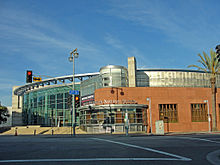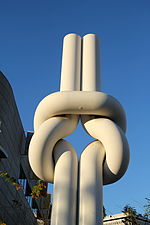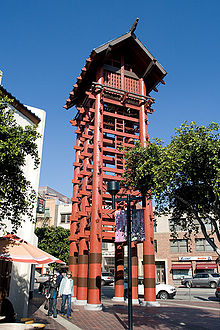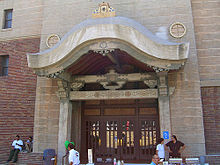|
"Explore Neighborhoods Within Neighborhoods"
| |
Little Tokyo District Lease Properties, Downtown Los AngelesLittle Tokyo, also known as Little Tokyo Historic District, is a district in Downtown Los Angeles and one of only three official Japantowns in the United States, all three of which are in California (the other two are in San Francisco and San Jose). Founded around the beginning of the 20th century, the area, sometimes called Lil' Tokyo, J-Town, 小東京 (Shō-tōkyō), is the cultural center for Japanese Americans in Southern California. It was declared a National Historic Landmark District in 1995. HistoryThe original boundaries of Little Tokyo extended east and south of the present location, and covered approximately one square mile. The area was a magnet for immigrating Japanese until the Exclusion Act of 1924 halted any further migration. Shops were along First Street, and vegetable markets were along Central Avenue to the south. Japanese Americans were a significant ethnic group in the vegetable trade, due to the number of successful Japanese American truck farms across Southern California. In the late 1970s, a redevelopment movement started as Japanese corporations expanded overseas operations and many of them set up their US headquarters in the Los Angeles area. Several new shopping plazas and hotels opened, along with branches of some major Japanese banks. Although this redevelopment resulted in many new buildings and shopping centers, there are still some of the original Little Tokyo buildings and restaurants, especially along First Street. During the 1970s and 1980s, artists began to move into nearby aging warehouse spaces in the area, forming a hidden community in the industrialized area. Al's Bar, Gorky's, the Atomic Cafe, and LA Contemporary Exhibitions (LACE) are some well-known sites. Land use has been a contentious issue in Little Tokyo due to its history, the proximity to the Los Angeles Civic Center, the role of Los Angeles as a site of business between Japan and America, and the increasing influx of residents into the Artist District. Consequently, Little Tokyo, like other ethnic urban enclaves, is constantly threatened with development that could eradicate it. Conversely, because the Japanese American community was politicized by the internment and subsequent Redress and Reparations effort, and because of the global and local growth of overseas Japanese investment, Little Tokyo has resisted eradication and has continued to exist as a tourist attraction, community center, and home to Japanese American senior citizens and others. The current site of Parker Center, the Los Angeles Police Department's former headquarters, was the original site of the Nishi Hongwanji Buddhist temple. The south edge of the block where Parker Center stands was part of the First Street business strip of shops. The warehouses and new condominiums to the east of Little Tokyo were once residential areas of the district. The Weller Court mall was opposed by some people in the community because it redeveloped a strip of family-owned small businesses. Community activists established First Street as a historic district in 1986, In 2004, they helped reopen the Far East Cafe, an acknowledged community hub. Neighborhood
Japanese American National Museum
At its peak, Little Tokyo had approximately 30,000 Japanese Americans living in the area. Little Tokyo is still a cultural focal point for Los Angeles's Japanese American population. It is mainly a work, cultural, religious, restaurant and shopping district. However, the recent boom in downtown residential construction is changing the nature of Little Tokyo. What is left of the "original" Little Tokyo can be found in roughly five large city blocks. It is bounded on the west by Los Angeles Street, on the east by Alameda Street, on the south by 3rd Street, and on the north by First Street, but also includes a substantial portion of the block north of First and west of Alameda, location of the Japanese American National Museum, the Go For Broke Monument, and a row of historic shops which lines the north side of First Street. A timeline has been set into the concrete in front of these shops, using bronze lettering, showing the history of each of the shops from the early 20th Century until the renovation of the district in the late 1980s. More broadly, Little Tokyo is bordered by the Los Angeles River to the east, downtown Los Angeles to the west, L.A. City Hall and the Parker Center to the north, and the newly named Arts District (made up of warehouses converted into live-work lofts) to the south. The community is served by the Metro Gold Line at Little Tokyo/Arts District station at the northeastern perimeter of Little Tokyo and is also walkable from the Metro Red and Purple subway lines at either Civic Center station or Union Station - with connections to Amtrak, Metrolink, Metro Silver Line BRT, and Foothill Transit's Silver Streak BRT services. AttractionsCultural Attractions
The Japanese American Cultural & Community Center is located in Little Tokyo, as well as the Japanese American National Museum. The extension of the Museum of Contemporary Art, formerly called the Temporary Contemporary and now known as the Geffen Contemporary (named after David Geffen), is also in Little Tokyo. East West Players, one of the nation's first Asian American theater companies, specializing in live theater written and performed by Asian American artists, is located in Little Tokyo, performing in the David Henry Hwang Theater. There is also the Aratani/Japan America Theater, which features plays and musical performances. Visual Communications, an Asian Pacific American media arts organization, has its offices in Little Tokyo, and each May, annually presents VC FilmFest (Los Angeles Asian Pacific Film Festival), in several venues around Little Tokyo. Additionally, the visual arts are represented by the 30 year-old arts non-profit, LAArtcore which devotes itself to creating awareness of the visual arts through 24 exhibitions each year along with educational programming. The Nisei Week festival is held every August, and includes a large parade, a pageant, athletic events, exhibits of Japanese art and culture, a taiko drum festival, the Japanese Festival Street Faire, a car show, and other events. A queen and court will be selected. Little Tokyo has quite a few public sculptures and artwork, including a monument to Astronaut Ellison S. Onizuka, a Japanese American from Hawaiʻi who was a mission specialist on the Space Shuttle Challenger when it disintegrated during takeoff in 1986 and another monument to Chiune Sugihara, Japanese consul to Lithuania before World War II and Righteous among the Nations. There are also two Japanese gardens in the area open to the public—one is next to the Japanese American Cultural and Community Center and the other is a rooftop garden in the Kyoto Grand Hotel and Gardens, formerly the New Otani Hotel. The Go For Broke Monument commemorates Japanese Americans who served in the United States Military during World War II. 
Shopping and Dining
There are numerous Japanese restaurants, catering to both Japanese and non-Japanese clientele. Many of them specialize in one type of Japanese cuisine, such as donburi, Japanese noodles (soba, ramen and udon), shabu-shabu (which translated from Japanese means 'swish-swish', referring to the motion of dipping meat and vegetables in a communal bowl of boiling water), Japanese curry, sushi, or yakitori. There are also a number of yakiniku restaurants, where meat is often cooked on a small grill built into the center of the table. Little Tokyo is the birthplace of the California roll, invented by a chef named Ichiro Mashita at the Tokyo Kaikan sushi restaurant. Two wagashi (Japanese sweets) shops located in Little Tokyo are among the oldest food establishments in Los Angeles. Fugetsu-do, founded in 1903, appears to be the oldest still-operating food establishment in the city and the first one to celebrate a centennial; its best-known offerings include mochi and manjū, and it claims to be an inventor of the fortune cookie. Mikawaya was founded in 1910, but is now well known as the company that introduced mochi ice cream to the United States in 1994. Little Tokyo has several shops that specialize in Japanese-language videos and DVDs, while other shops specialize in Japanese electronics and video games. These are a great way to find Japanese video games that were never translated into English. There are also several stores that sell manga and anime related products. The Weller Court shopping mall has several restaurants, karaoke clubs, and a Bubble Tea cafe. For tourists visiting from Japan, there are a number of shops specializing in expensive name brand products such as Coach handbags. There is also a large bookstore, Kinokuniya, that is part of a well-known Japanese chain. They have a large selection of Japanese-language books, magazines, music CDs, manga, and anime, as well as a selection of English-language books on Japanese subjects and translated manga and anime. The Japanese Village Plaza is located roughly in the center of Little Tokyo. There are several restaurants in the plaza, plus a number of shops geared towards tourists. First Street and Second Street border Japanese Village Plaza and have a number of restaurants that are open later than those in the court. The Current loft buildings located near the Little Tokyo District are the; Little Tokyo Lofts. Preview all properties for lease below: Preview all properties for sale here: Preview all income properties for sale here: |

